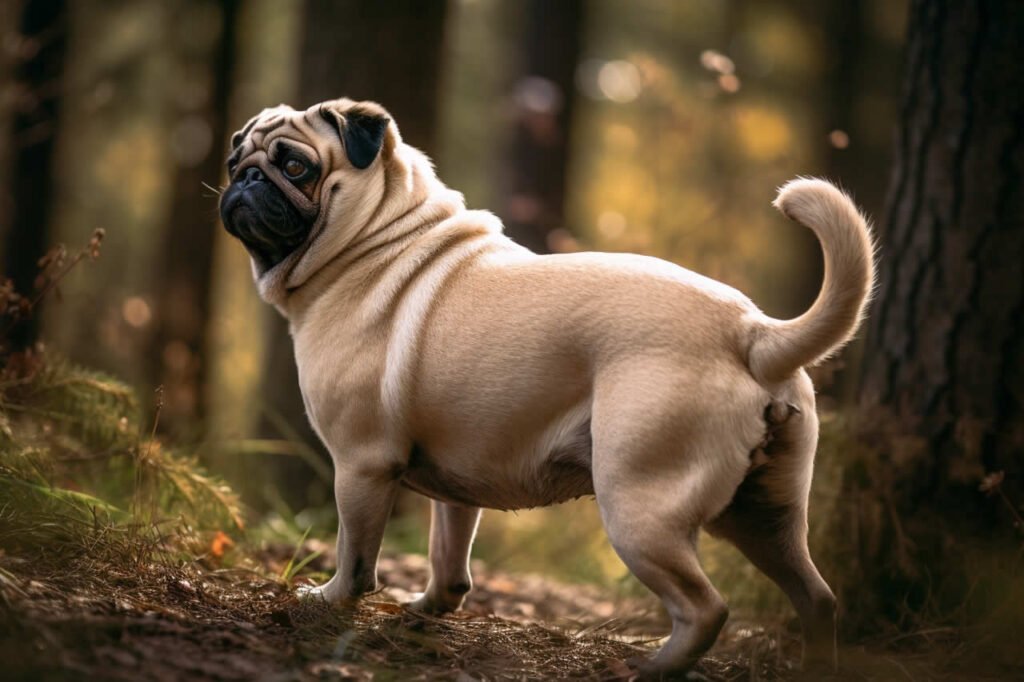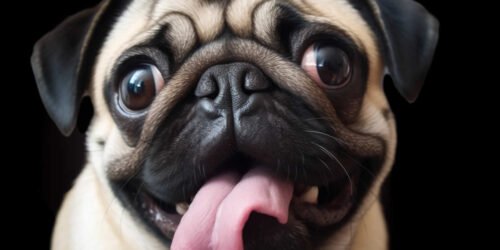Why is My Pug’s Tail Down?
Introduction
Are you puzzled, wondering why your pug’s tail is down instead of its usual lively curl? As a fellow pug parent, I’ve encountered this issue and found that it can be due to various reasons like illness or discomfort.
That’s why I’ve put my investigative cap on and conducted extensive research to get to the bottom of this curious canine conundrum. This insightful article will delve into potential causes for your pug’s drooping tail and offer tips on how to handle it – all part of our mission to keep that wag in your doggo’s swag! Ready for a tail-wagging adventure?

Table of Contents
- Introduction
- Reasons Why a Pug’s Tail Is Down
- Understanding and Addressing a Pug’s Tail Behavior
- Conclusion
Key Takeaways
- A pug’s tail being down can indicate illness or discomfort, such as straight tail syndrome or limber tail syndrome.
- Anxiety or fear can also cause a pug’s tail to droop, so providing a calm and safe environment is important.
- Anal gland issues are another possible cause for a pug’s downed tail and should be addressed promptly with veterinary care.
- Observing additional signs of pain or illness, creating a peaceful atmosphere at home, and consulting with a veterinarian are crucial in addressing the issue.
Reasons Why a Pug’s Tail Is Down
A Pug’s tail can be down due to illness, anxiety, or anal gland issues.
Illness or discomfort
Often, your Pug’s tail dropping is a sign of illness or discomfort. This can be due to multiple factors, ranging from minor injuries such as sprains to more serious health conditions. For example, senior Pugs may develop a condition called straight tail syndrome where their tail suddenly becomes straight.
Paying close attention to the position and movement of your pug’s tail can offer insightful clues about their wellbeing. An uncurled pug tail often indicates that he/she is experiencing some form of pain or discomfort; ignoring this sign would likely exacerbate the problem causing severe complications in the future.
Furthermore, inflammation resulting from an injury might also cause your Pug’s tail to appear broken or limp – a condition known as limber tail syndrome which could occur due to excessive physical activity or exposure to cold temperatures and it’s worth noting that it can be quite painful for dogs if not addressed promptly with veterinary care.
Anxiety or fear
In the emotional language of Pugs, a tail held close to the body often signals feelings of anxiety or fear. For instance, changes in routine—such as moving homes or introducing a new pet—might provoke these emotions in your pug and cause their once curly tail to go limp.
It’s important to understand that this is more than just an aesthetic change; it’s a cry for comfort from your furry pal.
Recognizing this sign can help you act promptly and provide appropriate comfort and reassurance. A welcoming environment is vital, but so too is patience—it may take time for your Pug’s anxiety levels to lower and their tail to regain its lively curl.
Meanwhile, try not to rush things or become frustrated with your four-legged friend as they navigate these unfamiliar circumstances. Keep an eye out for any additional signs of distress; if you notice something unusual about their behaviour beyond “Why Is My Pug’s Tail Down?”, don’t hesitate to get professional advice from your vet.
Anal gland issues
Understanding anal gland problems is crucial for every Pug owner. In dogs, these glands can become overfilled, blocked or irritated leading to discomfort and sometimes affecting the position of their tail.
Your pug’s tail may droop if there are issues with its anal glands – a clear sign that your furry friend is in distress.
The signs may vary from regular scooting on carpet to tail and posterior licking. A poor diet or genetic factors can contribute to these malfunctions, causing symptoms like a swollen anus. If you notice any unusual behaviour related to your pug’s rear end, especially changes in how it carries its tail, consult with a veterinarian as soon as possible for proper diagnosis and treatment.
Understanding and Addressing a Pug’s Tail Behavior
To better understand and address a Pug’s tail behaviour, it is important to watch for additional signs of illness or pain, provide a calm and safe environment, and consult with a veterinarian for proper diagnosis and treatment.
Watch for additional signs of illness or pain
As a pug owner, it’s important to watch for additional signs of illness or pain when your pug’s tail is down. This will help you better understand and address their behaviour effectively. Here are some key signs to look out for:
- Excessive Licking: If your pug is constantly licking the tail area, it could be a sign of pain or discomfort. Pay close attention to any redness, swelling, or sores in that area.
- Howling When Touched: If your pug howls or yelps when you touch their tail, it’s a clear indication that they’re experiencing pain. Be gentle and observe their reaction carefully.
- Immobilisation of the Tail: If your pug’s tail seems stiff or immobile, it could be due to an injury or underlying health issue. A normally active and wagging tail becoming still may require veterinary attention.
- Panting: While panting can be normal in certain situations, excessive panting without any obvious cause can be a sign of pain or discomfort in dogs. Monitor your pug’s breathing patterns closely.
- Loss of Appetite: A pug with a downed tail might also experience a loss of appetite as they connect the discomfort with mealtimes. Keep an eye out for any changes in eating habits.
- RSPCA – Pugs
- The Pug Diary
Provide a calm and safe environment
Creating a calm and safe environment for your pug is crucial when their tail is down. Dogs, like humans, can feel stressed or anxious in certain situations, and it’s our responsibility as pet owners to alleviate those feelings.
Start by creating a peaceful atmosphere at home – keep the noise level low, provide a comfortable resting area, and create predictable routines that your pug can rely on. Additionally, try incorporating calming activities into their daily routine such as gentle walks or interactive playtime.
This not only helps to relieve any built-up tension but also strengthens the bond between you and your furry friend. Remember, a relaxed environment goes a long way in helping your pug feel safe and secure.
Consult with a veterinarian for proper diagnosis and treatment
It is crucial to consult with a veterinarian if you notice your pug’s tail-down behaviour. A veterinarian has the expertise to diagnose and treat any underlying medical or behavioural issues that may be causing this.
They can conduct a thorough examination, identify any signs of illness or discomfort, and provide appropriate treatment options. Remember that every dog is unique, so it’s important to seek professional advice tailored specifically to your pug’s needs.
By working closely with a veterinarian, you can ensure your furry friend receives the care they deserve and get their wagging tail back in no time!
Conclusion
In conclusion, if you notice your pug’s tail being down, it is essential to pay attention and understand the underlying reasons. It could be a sign of illness, anxiety, or anal gland issues.
Providing a calm and safe environment, monitoring for additional signs of pain or discomfort, and consulting with a veterinarian can help address the issue and ensure your pug’s well-being. Remember that every pug is unique in its tail behaviour, so it’s important to observe their individual characteristics as well.






